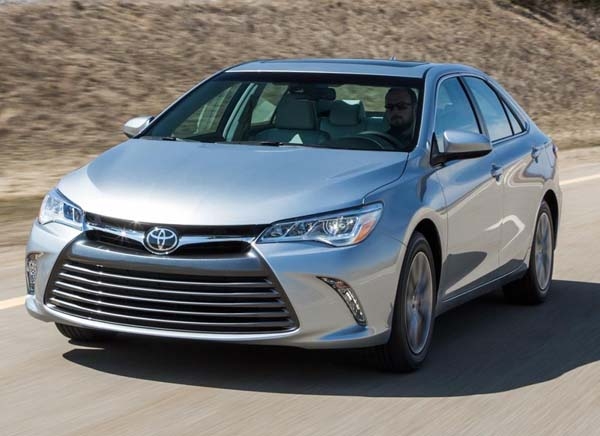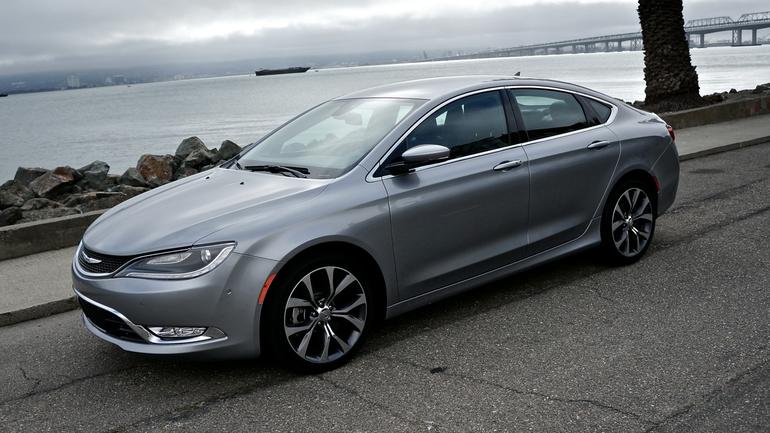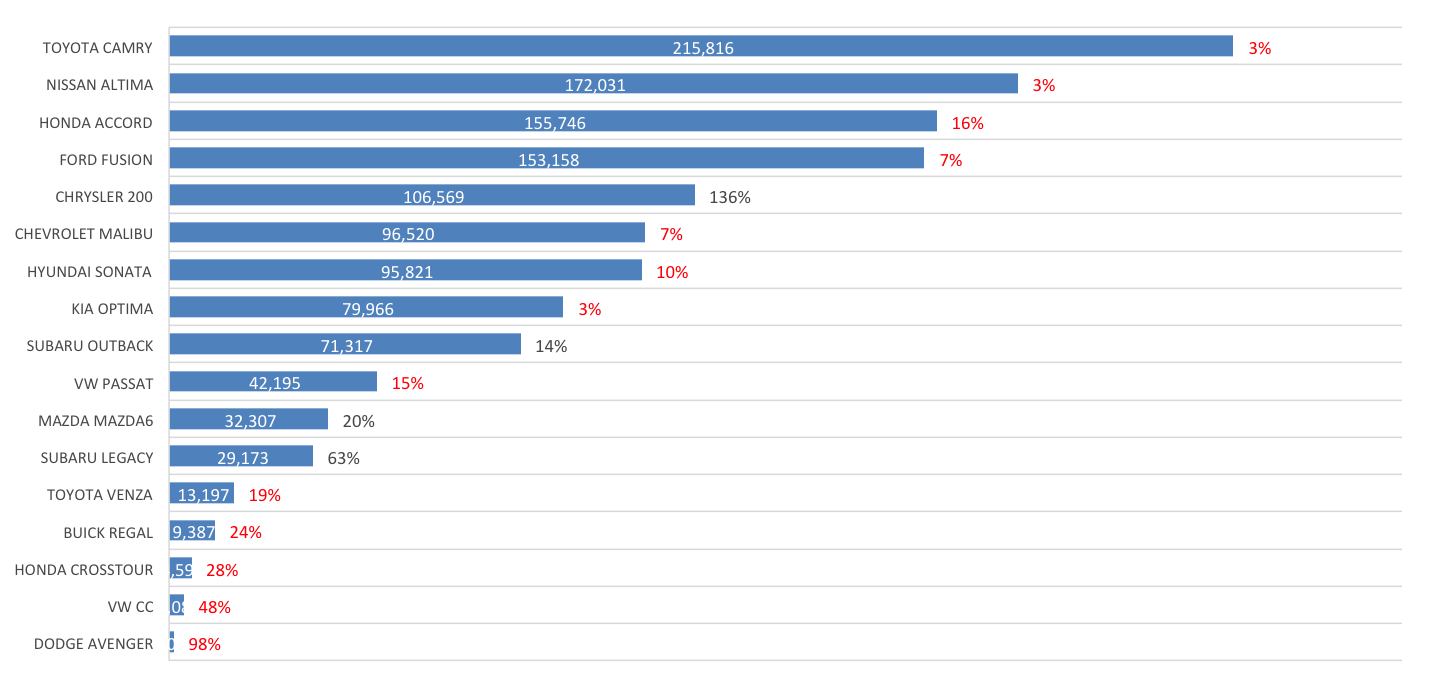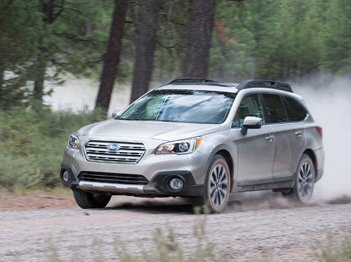
The mid-sized segment in the US shrank by 3% year-on-year, compared to a 4% increase in sales overall and in line with a fall of 4% among mainstream segments (non-premium subcompact to large). As a result, total sales in the segment at 1,166,633 were only a little bit over 100,000 higher than in the compact sector. If this trend continues, compacts may soon take over as the most popular mainstream cars in the US, unless mid-sized sales are lifted after new metal goes on sale in the second half in 2015: the new Chevy Malibu and Kia Optima, as well as the facelifted Honda Accord and VW Passat.
 Toyota Camry remains the clear segment leader, as it has been for the past 12 years (a remarkable run!). While the current, 8th generation was generally seen as a step back style- and quality-wise when it came out in 2011, the 2015 facelift helped a lot, and as a result the sales were down only 3%. The same cannot be said for the perennial #2, the Honda Accord, which lost a massive 16% compared to the same period last year, the largest fall from among the top 10 models. That left an open goal for the following pack and allowed the Nissan Altima to step up to #2 for the first time in, well, probably ever. The Accord is actually lucky to have landed in #3, as it was less than 3,000 units ahead of the Ford Fusion. Interesting, the Altima, Accord and Fusion all came out in 2013, but given its dismal performance its not surprising that the Accord is the first one to receive a facelift, which will go on sale soon.
Toyota Camry remains the clear segment leader, as it has been for the past 12 years (a remarkable run!). While the current, 8th generation was generally seen as a step back style- and quality-wise when it came out in 2011, the 2015 facelift helped a lot, and as a result the sales were down only 3%. The same cannot be said for the perennial #2, the Honda Accord, which lost a massive 16% compared to the same period last year, the largest fall from among the top 10 models. That left an open goal for the following pack and allowed the Nissan Altima to step up to #2 for the first time in, well, probably ever. The Accord is actually lucky to have landed in #3, as it was less than 3,000 units ahead of the Ford Fusion. Interesting, the Altima, Accord and Fusion all came out in 2013, but given its dismal performance its not surprising that the Accord is the first one to receive a facelift, which will go on sale soon.
 In #5 is the star performer of the sales chart, the Chrysler 200, which enjoyed an enormous 136% sales growth compared to H1 2014. Given how much better the current model, which went on sale in the second half of 2014, is than its awful predecessor the big jump in sales should not come as a surprise, especially that the model essentially also replaced Dodge Avenger in the Fiat Chrysler stable. Nonetheless, the market has clearly embraced the not only the new, softer design aesthetic of the 200, but also the Italian roots of its Compact U.S. Wide platform. Through its huge growth the 200 also vaulted over Chevrolet Malibu, relegating its Michigan neighbor to 6th spot. The aging Chevy’s replacement is ready and promises to lift the model’s fortunes once again. As is, in H1 2015 it was the last of the mid-sized sedans from the American “Big Three”, which interestingly occupied spots 4,5 and 6, while the top 3 was all cars from Japanese brands.
In #5 is the star performer of the sales chart, the Chrysler 200, which enjoyed an enormous 136% sales growth compared to H1 2014. Given how much better the current model, which went on sale in the second half of 2014, is than its awful predecessor the big jump in sales should not come as a surprise, especially that the model essentially also replaced Dodge Avenger in the Fiat Chrysler stable. Nonetheless, the market has clearly embraced the not only the new, softer design aesthetic of the 200, but also the Italian roots of its Compact U.S. Wide platform. Through its huge growth the 200 also vaulted over Chevrolet Malibu, relegating its Michigan neighbor to 6th spot. The aging Chevy’s replacement is ready and promises to lift the model’s fortunes once again. As is, in H1 2015 it was the last of the mid-sized sedans from the American “Big Three”, which interestingly occupied spots 4,5 and 6, while the top 3 was all cars from Japanese brands.
Following closely were the Korean brothers Hyundai Sonata and Kia Optima. However, their close position masks very different fortunes for the two. The Optima in #8 saw its sales fall only by 3% despite its successor waiting to go on sale in the second quarter of the year; by contrast, the Sonata saw its sales fall by over 10% despite the car being just over a old! In fact, most of the H1 2014 sales were made up of the previous-generation model, meaning the new model actually lost sales compared to its predecessor year-on-year! The current 7th generation Sonata was criticized from the moment it hit the market for its conservative design inside and out, not unlike Toyota’s 8th generation Camry was back in 2011. A major facelift may be on the way rather soon…

 The Subaru Outback (#9) and Legacy (#12) are an interesting case study of the brand’s position in the US. Unlike for other Japanese brands, which mostly produce bread n’ butter sedans, the higher-riding Outback wagon outsold the Legacy sedan by more than 2-to-1, despite the latter’s high 63% year-on-year growth (both were new for 2015). In fact, the popularity of the Outback has been such that Subaru no longer sells a standard Legacy Wagon in the US; along with the Forester the model cements the image of Subaru as the purveyor of no-nonsense 4WD crossovers which are very popular in the regions of the country that see heavy snow in the winter.
The Subaru Outback (#9) and Legacy (#12) are an interesting case study of the brand’s position in the US. Unlike for other Japanese brands, which mostly produce bread n’ butter sedans, the higher-riding Outback wagon outsold the Legacy sedan by more than 2-to-1, despite the latter’s high 63% year-on-year growth (both were new for 2015). In fact, the popularity of the Outback has been such that Subaru no longer sells a standard Legacy Wagon in the US; along with the Forester the model cements the image of Subaru as the purveyor of no-nonsense 4WD crossovers which are very popular in the regions of the country that see heavy snow in the winter.
Closing off the top 10 is the VW Passat, a 2012 model that like the smaller Jetta started off well but is now losing market share quickly (15% down on H1 2014). Despite being designed specifically for the US, the super-conservative style means the model has trouble attracting customers, and while a facelift is coming soon it remains to be seen whether it’ll help matters a whole lot. Behind it at #11 is the Mazda6, a model beloved by road-testers for its best-in-class handling, whose sales grew a nice 20%, albeit from a low base.
The cars in the bottom 5 are a hodgepodge of aging misfits (the #12 Toyota Venza and #14 Honda Crosstour, both based on previous-generation Camry and Accord platforms), too-small-and-too-expensive-for-the-US European imports (the #13 Buick Regal/Opel Insignia and #15 VW CC) and a discontinued model, the Dodge Avenger.


